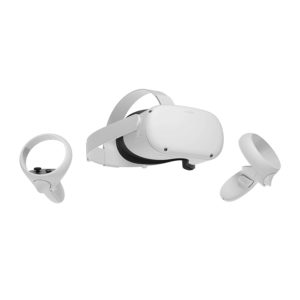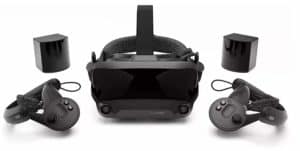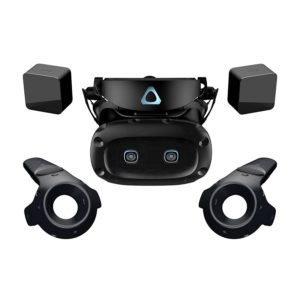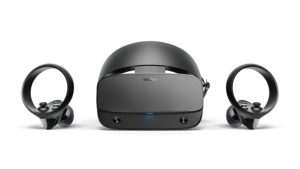Best VR Headset in 2023
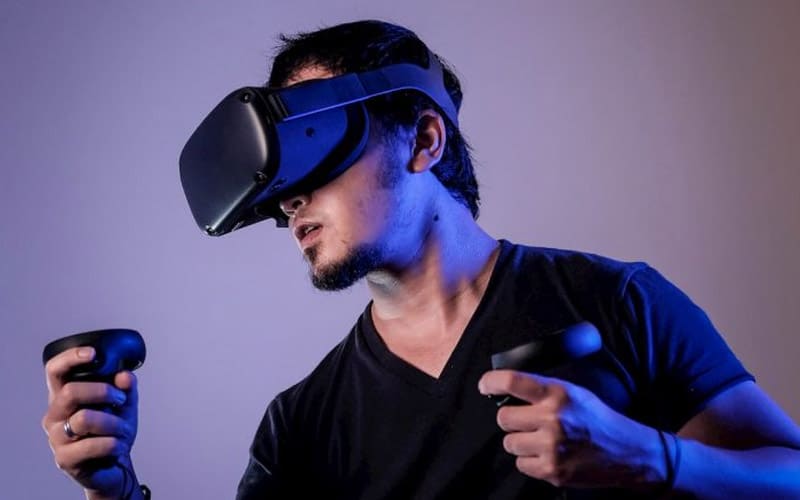
Table of Contents
Looking for the best VR headset? You’ve come to the right place.
From the superlative Half-Life: Alyx and immersive dogfighting of Star Wars: Squadrons to the sleuthing antics of L.A. Noire: The VR Case Files and the endlessly updated No Man’s Sky, there’s no shortage of great VR games despite the technology still struggling to pierce through as a mainstream gaming platform. We’re seeing a much-needed shift away from gimmicky VR experiences that defined the early days of the technology to games tailor-made for VR, not least VR’s ‘killer app,’ Half-Life: Alyx.
There’s arguably never been a better time to jump, especially with a decent spread of VR headsets to choose from. There’s also been an important shift here: manufacturers have moved towards convenience, doing away with the convoluted calibration of outside-in ‘lighthouse’ tracking sensors for infinitely more user-friendly inside-out tracking. The price tag remains prohibitive, but it’s never been easier to justify investing in the most immersive way to experience games.
Today, we’re highlighting the best VR headsets out there, with the ultimate aim of guiding newcomers and seasoned players alike towards a headset that suits their requirements and, probably, more importantly, their budget.
Products at a Glance
How We Picked
For us, the best VR headset is a piece of gaming equipment you’ll want to use whenever you’ve got a few hours to spare instead of a pricey reminder of a misjudged impulse buy gathering dust on a shelf. To tempt you into playing often and for a long time, the best VR headset needs a balance of the right specifications, a price that won’t leave you destitute, and broad compatibility with the best VR games currently available.
More technically, it’s the combination of factors such as design (comfort and convenience), screen type and resolution, the field of view, refresh rate, tracking system, controllers, and, of course, price that dictates whether a headset is a winner or an expensive paperweight.
Ultimately, we’ve singled out five VR headsets that impressed us at every turn for various reasons, whether that’s pure VR performances, price, or compatibility with a particular gaming platform. Below, you’ll find a brief review to get you acquainted with each VR headset and help you choose the right one for you. And, to round things off, we’ve slotted in a ‘Things to Consider’ section at the end with a few top buying guide-style pointers.
Things To Consider
Design and Comfort
Headset design, and more importantly, comfort can make or break a headset. The highest refresh rates and resolution are effectively useless if you can’t bear having the headset perched on your head for more than 10 minutes at a time. Look out for features such as a balanced weight across the entire head, padded cushioning, and adjustable straps to find that perfect fit. Overall weight also has an impact, so opt for lightweight headsets if this is a concern.
Tracking Sensors
There are two types of tracking sensors used by VR headsets to translate player motion into on-screen action: outside-in and inside-out tracking.
Outside-in tracking uses an arrangement of external sensors or stations often called ‘lighthouses’ to track the position of the headset and controller. Inside-out tracking incorporates the sensors into the headset itself. Outside-in tends to be more accurate at the cost of a more involved setup and frequent calibration, while inside-out sacrifices some accuracy for a more contained and convenient setup. The accuracy gap grows smaller with each new inside-out headset that hits the market, though, so this isn’t as much of a compromise as it once was.
You’ll also regularly come across terms like 3DoF and 6DoF when eyeing up VR headset specifications. These refer to Degrees of Freedom. 3DoF allows the headset to register head turns and swivels in all directions. 6DoF enables the headset to track all head movements alongside body movements in all directions, whether moving left and right or forward and backward.
Refresh Rates and Motion Sickness
You’ve probably heard stories of people trying their hand at VR only to swiftly remove the headset and dash to the bathroom to discharge their lunch. Sadly, this comes down to simple physiology for some people who are more prone to motion sickness than others. However, in many cases, motion sickness while VR gaming can be traced back to low refresh rates, or in layman’s terms, the rate at which the headset cycles images or frames. Low refresh rates tend to wreak havoc as the eyes, inner ear, and other senses try to make sense of the choppy motion on the screen.
Similarly, latency also plays its part in motion sickness: nothing quite confuses the brain like a noticeable, stuttered delay between a headset or controller motion and the on-screen response.
Opting for a headset with a refresh above 60 Hz or ideally above 90 Hz and low latency dramatically reduces the chances of motion sickness.
System Requirements
While all-in-one standalone VR headset exists, our guide focuses mainly on headsets that pair with either a PC (or console). As such, it’s vitally important to check that your PC has the hardware chops to handle the demands of VR. The system requirements vary from model to model with the more premium headsets, such as the Valve Index and HTC Vive Cosmos Elite, veering more to what we’d consider high-end gaming rigs. An under-powered rig can result in a shoddy VR experience with low refresh rates, which in turn can heighten the chance of motion sickness, as we covered just above.
Product Reviews
- 1832 x 1920 resolution per eye
- 90-degree FOV
- 90 Hz refresh rate
- Versatile
- Affordable price point
- Facebook login required
- PC pairing requires purchase of Oculus Link cable
The Oculus Quest 2 is neither the best nor the most expensive VR headset, but that’s precisely why we like it so much. It’s a well-designed, comfortable entry-level headset with sufficiently capable specifications for a stellar experience in all VR games under the sun.
Technically, it’s an all-in-one standalone headset that can run a selection of games on the Oculus Store un-tethered thanks to a Qualcomm Snapdragon XR2 chip, 6 GB of RAM, and 64 GB/256 GB of storage. But, the Oculus Quest 2 pairs equally well with a PC thanks to the Oculus Link cable or any third-party USB Type-C cable, opening the door to VR games on Steam or your digital distribution platform of choice.
With a resolution of 3664×1920 (1832 x 1920 resolution per eye) beamed through a good quality LCD, 90-degree field of view, built-in speakers with cinematic 3D positional sound, and up to a 90 Hz refresh rate delivers a responsive and pleasant VR experience. The inside-out tracking sensors mean an effortless setup. And, the lightweight design, glasses spacer, and adjustable head strap make it one of the most comfortable headsets for lengthy VR sessions on the market.
There is one major drawback to Oculus Quest 2: a mandatory Facebook account and sign-in. While this isn’t the end of the world for many, others may be wary about funneling yet more data free of charge to Facebook’s marketing edifice.
- Up to 144 Hz refresh rate
- Superb audio
- 130-degree FOV
- Dual full RGB LCD 2880 x 1600 display
- Premium build quality and materials
- Best-in-industry controllers
- Free copy of Half-Life: Alyx
- Expensive
- High system requirements for best VR experience
- Hard to find
It’s fair to say that the Valve Index is the best and most complete VR headset currently available, the fruit of Valve’s efforts to bring to market a headset designed through-and-through to deliver a premium gaming experience. If it weren’t for a $1000 price tag for the complete kit (headset, controllers, and Base Station sensors), we’d have no qualms about slotting it in as our top pick.
The Valve Index specifications are best-in-class across the board: dual canted full RGB display with a resolution of 2880 x 1600 that delivers a clearer and sharper image than your staple VR LCDs. Alongside the Valve Index pushes a broad 130-degree field of view, the best of all the headsets on the market, a variable refresh rate that tops out at a buttery smooth 144 Hz alongside 80/90/120 Hz, and superb off-ear speakers.
The best-in-industry Valve Index controllers are simply phenomenal, with hand, motion, and even per-finger tracking for interactions and gestures you can’t find elsewhere. All these combine to offer the best VR experience money can buy.
The pros don’t stop here, though, as the Valve Index marries excellent construction, high-quality materials such as antimicrobial fabric, perfect weight distribution, and a wealth of ergonomic fit adjustments. In other words, it’s supremely comfortable to wear.
All this does come with some caveats, not least the price tag, but also the need for a suitably high-end PC to get the most out of the Valve Index. Similarly, the outside-in sensor setup using Valve’s Base Stations necessitates a bit more setup before you’re up and gaming. Finally, and hopefully not for too long, stock shortages mean it can be quite the task to get your hands on a Valve Index.
Oh, and let’s not forget it ships with a free copy of Half-Life: Alyx, a game anyone serious about experiencing the very best of VR should already be eyeing up.
- 2880 x 1700 resolution
- 90 Hz refresh rate
- 110-degree FOV
- Base Station tracking
- Flip-up visor
- Expensive
- Outside-in setup required
While the Valex Index is our top recommendation for those looking for a premium VR experience, it’s in good company on the higher end of the pricing scale with the HTC Vive Cosmos Elite.
Designed to remedy the issues plaguing the HTC Vive Cosmos, the Elite aims to deliver a responsive and immersive VR experience and largely succeeds in that ambition. Under the hood, it features a pair of LCD panels with a combined resolution of 2880 x 1700 alongside a more than respectable 90 Hz refresh rate and 110-degree field of view. Visually, the HTC Vive Cosmos is one of the best options on the market. Add to that a rich stereo audio experience thanks to on-ear, form-fitting headphones.
These specifications fall behind the Valve Index but still deliver a high-quality experience aided by good construction and a comfortable crown fit and a handy flip-up visor should reality beckon mid-session. The Vive controllers, while excellent, lack the tracking depth of Valve’s.
The HTC Vive Cosmos Elite uses a pair of Base Stations allied to a Motion Faceplate to deliver accurate tracking and 6DoF. Compared to inside-out variants, this does require a more of an elaborate setup, but for us, the initial effort is worth the extra precision and more responsive VR experience.
The HTC Vive Cosmos Elite certainly warrants the $900 asking price, and with the Index in such a short supply, this headset is a worthy alternative. If you can get your hands on an Index, there’s no doubt that Valve’s offering trumps the Elite, though.
- Affordable
- Excellent value
- 2560 x 1600 resolution
- 80 Hz refresh rate
- 110-degree FOV
- Officially discontinued by Facebook
- Superseded by Oculus Quest 2
The Oculus Rift S may no longer command the place of honor in Oculus’ VR line-up, but it’s nevertheless one of the most value-packed mid-range options out there, especially for PC VR gaming. It’s a careful balance of visual performance, comfort, and ease of use.
While it’s been superseded by the newer Oculus Quest 2, which is priced lower and doesn’t deliver the same visual fidelity as premium headsets like the Valve Index, the Oculus Rift S is still a handy piece of VR kit that should suit PC gamers that want a well-balanced VR experience without shelling out exorbitant amounts of money.
With an LCD offering a 2560 x 1600 resolution, 80 Hz refresh rate, and 110-degree FOV, packed in a design that is both sleek and comfortable, the Rift S has all the hardware you need for an excellent VR experience. It’s lightweight, well put together, and boasts inside-out tracking with top-notch accuracy and responsive Touch Controllers, so no fussing about with outside-in lighthouses. The Oculus Rift S also shines for compatibility with a huge library of games via the Oculus Store and, of course, Steam.
As of April 2021, Facebook has officially discontinued production of the Oculus Rift S, with no plans to replenish existing stocks “generally speaking,” signaling the end of the headset’s five-year run. If you happen to stumble across a retailer with any remaining stock, act quickly.
- Access to PlayStation exclusive VR games
- 1920 x 1080 per eye resolution
- Up to 120 Hz refresh rate
- 100-degree FOV
- Requires a PlayStation console
With Xbox shunning the VR world so far and Nintendo limiting its efforts to the cardboard Toy-Con VR Goggles, PlayStation remains largely unrivaled in the console VR space as the only platform to offer a genuine and surprisingly impressive VR headset in the Sony PlayStation VR.
Naturally, it’s fully integrated with the PlayStation ecosystem, both a boon and a limiting factor. You get access to a growing library of PlayStation exclusive VR games such as Paper Beast, From Software‘s Deracine, Astro Bot: Robo Rescue, and Rez Infinite, to name a handful, but need a PlayStation console and our cut-off from PC VR titles. The console-requirement aspect is, all costs considered, a cheaper route than having to pay for a gaming PC with the chops to handle VR, though, so as far as affordable ways to get in VR gaming, you could do worse.
If we turn to specifications, the Sony PlayStation VR is no slouch with a duo of 1920 x 1080 OLED panels, 90 Hz and 120 Hz refresh rate, and 100-degree field of view, all packaged with a tracking system pairing nine tracking LEDs mounted on the headset and the PlayStation Camera. Compared to your standard fare outside-in system, the Sony PlayStation VR is a breeze to set up, and Sony’s designed the headset first and foremost for comfort.
Our Verdict
Our top pick is the Oculus Quest 2. Despite not being the best nor the most expensive headset out there, it’s an excellent entry point into the world of VR that won’t break the bank.
If money is no object, then the Valve Index stands proudly as the best consumer VR headset on the market today. Best-in-class specifications, high-quality construction, and superb controllers only scratch the surface of what the Index offers. The HTC Vive Cosmos Elite is a viable premium VR headset alternative at a slightly more stomach price point.
The Oculus Rift S delivers an excellent mid-range VR experience at an affordable price point, that is, if you can get your hands on one. And, finally, for console VR gaming, the Sony PlayStation VR stands uncontested as the best and only option.
Let us know in the comments section if you have any questions or concerns. Otherwise, we’ll wrap up our guide to the best VR headsets.


